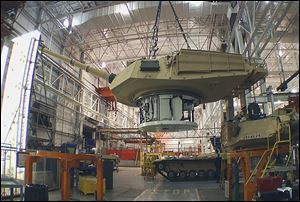
Lima tank plant to remain vital
5/14/2013
This undated file photo shows the production of an Abrams tank in Lima, Ohio.
There’s been a lot of confusion lately about the future of the Joint Systems Manufacturing Center in Lima (JSMC). We want to set the record straight on this critically important facility (“Tanks for nothing,” editorial, May 6).
The U.S. Army has stated that it plans to keep the current fleet of Abrams tanks in use for at least another four decades, while continuing to modernize tanks with the newest capabilities. The next generation of new tanks is already being designed under a contract that the Army awarded this year. The Army plans to begin producing this tank in 2018.
What the Army hasn’t planned for is how to maintain the critical skills in the industrial base and throughout the supply chain that are necessary to build and modernize those vehicles.
Two years ago, the Obama Administration proposed a budget that would have idled work to upgrade the Abrams tanks until 2017, when the Army planned to begin upgrading our current tanks with the latest capabilities. That proposal, unfortunately, would have jeopardized an industrial base that would have been costly and time-consuming to restart.
What’s at stake is not just employment for the highly skilled workers at JSMC. Also at stake is the existence of small businesses across the country with thousands of skilled employees supplying unique parts and services that support the tank program and other defense systems. There’s no certainty that those capabilities can be recreated if they’re left to disappear now.
In our review of the administration’s proposal to interrupt production, it became clear that members of the administration did not have an understanding of the industrial base, let alone the impact of a production shutdown, nor an agreed-upon cost assessment to shut down and restart the production line.
And while administration officials agreed there would be a cost to shut down the line, they failed to put those costs into their budget proposal. By temporarily mothballing the facility, the administration would have been entering blindly into the unknown, while hoping to come back in a few years to start upgrading the latest-generation tank that the Army says it needs.
Such a move would have threatened our national security flexibility. It ultimately would have resulted in few, if any, cost-saving benefits.
It is cheaper and smarter to slow down production and keep the plant open than to shut it down and attempt to restart it in a few years. With this cost-benefit analysis in mind, Congress, with broad bipartisan support, chose to sustain the minimum level of Abrams upgrade work necessary to avoid risk to these unique production capabilities without knowing the cost or true implications.
After studying the situation more fully, the Army has since abandoned its plan to mothball the line, recognizing the potential impact this decision would have on its ability to continue its planned work in the future. The Army’s hope is that it can sustain the line through upgrading tanks for foreign customers, in combination with the minimum sustaining investment made by Congress.
The Army plans to keep the current fleet of Abrams tanks in use for at least another 40 years, while repeatedly modernizing it with new capabilities over time. To do so, it is vital that we sustain our country’s ability to outfit our soldiers with the most powerful tank in the world.
Sustaining that ability requires attention to our advanced industrial base, and keeping a long-term perspective on the investment of taxpayer dollars.
ROB PORTMAN, U.S. Senate
JIM JORDAN, U.S. House of Representatives4th District, Ohio Washington